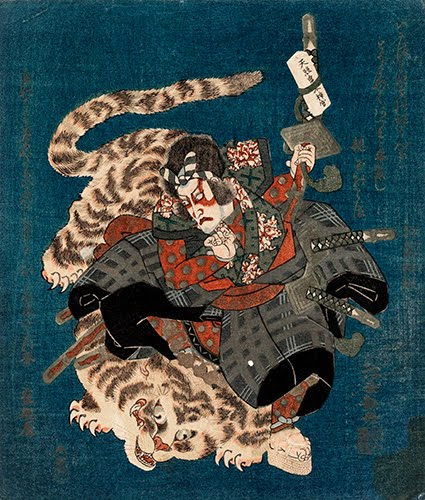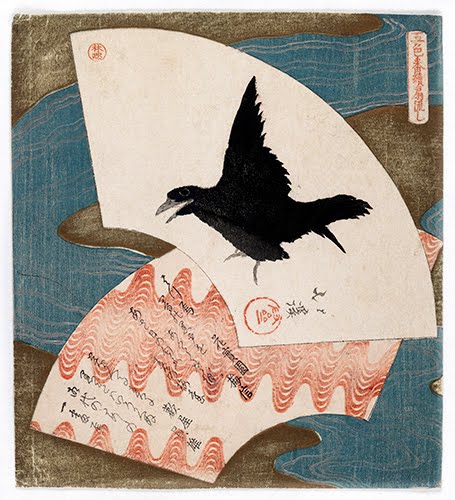Surimono Time for the New Year
I did it before and I’m doing it again: surimono to celebrate the New Year. In the West, we don’t really make little works of fine art to celebrate the New Year. In Japan, the surimono—“printed thing”—was a color woodcut print popular from the 1790s to the 1830s, the classic period of the ukiyo-e style. Surimono were not only created for New Year, but also for Cherry Blossom season, birthdays, and announcements.
Surimono were produced on commission—not available at the local Hallmark store. That made them luxury items sold in limited quantities. They were commissioned by wealthy people, poets, and the literati for circulation among their peers. Since ukiyo-eartists were considered “craftspeople” (printmaking was not considered a fine art form in Japan until well into the 1900s), they eagerly fulfilled the demand for these works following the aesthetics of the patrons rather than being bound by what was “common taste.”
Subject matter in surimono was only restricted by the patrons’ imaginations. Popular images were zodiac signs, lucky symbols, nature, historical events, and kabuki play scenes. The extensive writings often seen on surimono include poems and dedications to the patrons.
 |
| Ukiyo Utayoshio (active 1830–1835, Japan), Ichikawa Danjuro VII as Kokusenya Fighting the Tiger, surimono for the Tsurunova Poetry Club, Osaka, ca. 1831. Color woodcut on paper, sheet: 10 7/8" x 7 ¼" (27.7 x 18.4 cm). © 2019 Brooklyn Museum. (BMA-2669) |
This surimono was commissioned by a poetry club. I’m really not sure why this kabuki play would be popular at New Year, but the subject was very popular in Osaka. It could be that the theme of the play, about patriotic fervor, self-sacrifice, and big battle scenes appealed to the people of Osaka whom those in Edo (Tokyo) considered less sophisticated.
This scene comes from the play Battles of Kokusenya (Coxinga), which, like many kabuki dramas, began as a bunraku drama (puppet theater). It’s the story of a Sino-Japanese guy who decides (in 1644) to go back to China with his parents (Chinese father and Japanese mother) in order to fight the Manchus who were trying to end the Ming Dynasty. The decisive scene is Kokusenya fighting a tiger, who ultimately helps him build an army to fight the Manchu.
The tiger would be a very auspicious New Year animal. The animal was a symbol for one of the cardinal directions (west), and with the dragon was considered part of the yin yang idea. The tiger represented light and the earth.
The Osaka school of ukiyo-e artists is not as well written about as that of Edo. Ukiyo Utayoshio is known only for prints bearing his name in a five-year period. Nothing is known of his artistic development. His energetic figures and dynamic composition, however, resemble the style of other Osaka school artists, including the most famous: Gosotei Hirosada (1819–1863). The Osaka ukiyo-eschool is renowned almost exclusively for theater prints.
 |
| Totoya Hokkei (1780–1850), Black Crow for New Year, surimono from the Five Colors for the Floating Fans series, 1825. Color woodcut on paper, sheet: 8" x 7 3/8" (20.3 x 18.7 cm). © 2019 Brooklyn Museum. (BMA-2613) |
In Japan, the crow is considered a divine messenger, a symbol of good luck, and also a symbol of the sun. Hearing the call of the crow in nature could denote a message from a departed loved one. I would image then that the importance of the hatsuyume (first dream of the New Year) would be enhanced if one dreamt of a crow.
Hokkei was the prize pupil of the great master landscape ukiyo-e artist Katsushika Hokusai (1760–1849). Hokusai himself produced many surimono. Hokkei has upped the luxury of this New Year’s card with the addition of gold leaf. He also imitated the landscape style of the snooty Kanō school that produced landscapes and screen paintings for the wealthy. The zig-zag river with gold leaf shores is a typical decorative device of the Kanō school. The river represents continuity and the future, an auspicious perception on New Year’s.
Correlations to Davis programs: Experience Printmaking: 4; Discovering Art History 4E: 2.3, 4.1; Discovering Art History Digital: 2.2, 4.1; The Visual Experience 2E: 3.5, 13.5


Comments